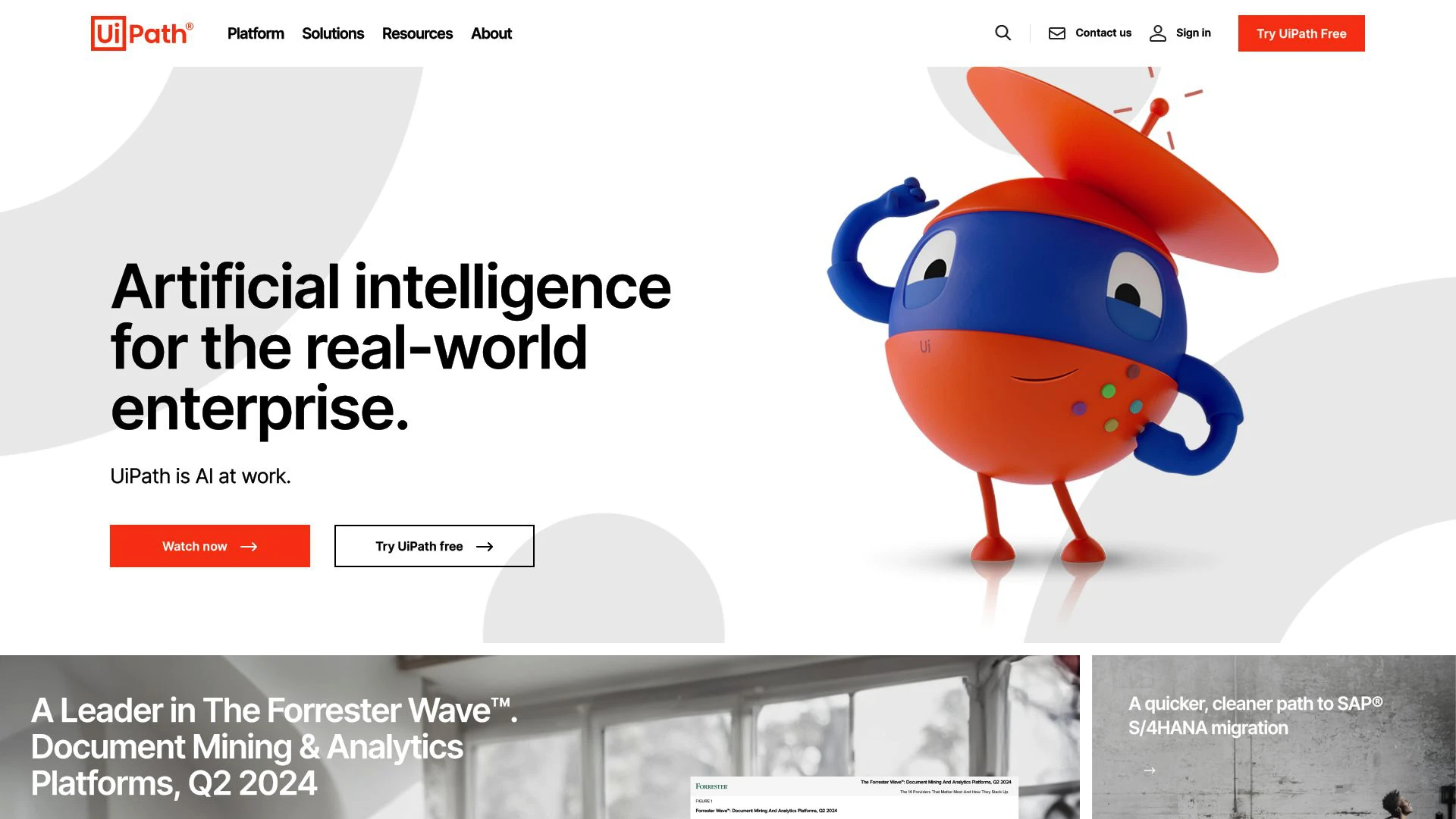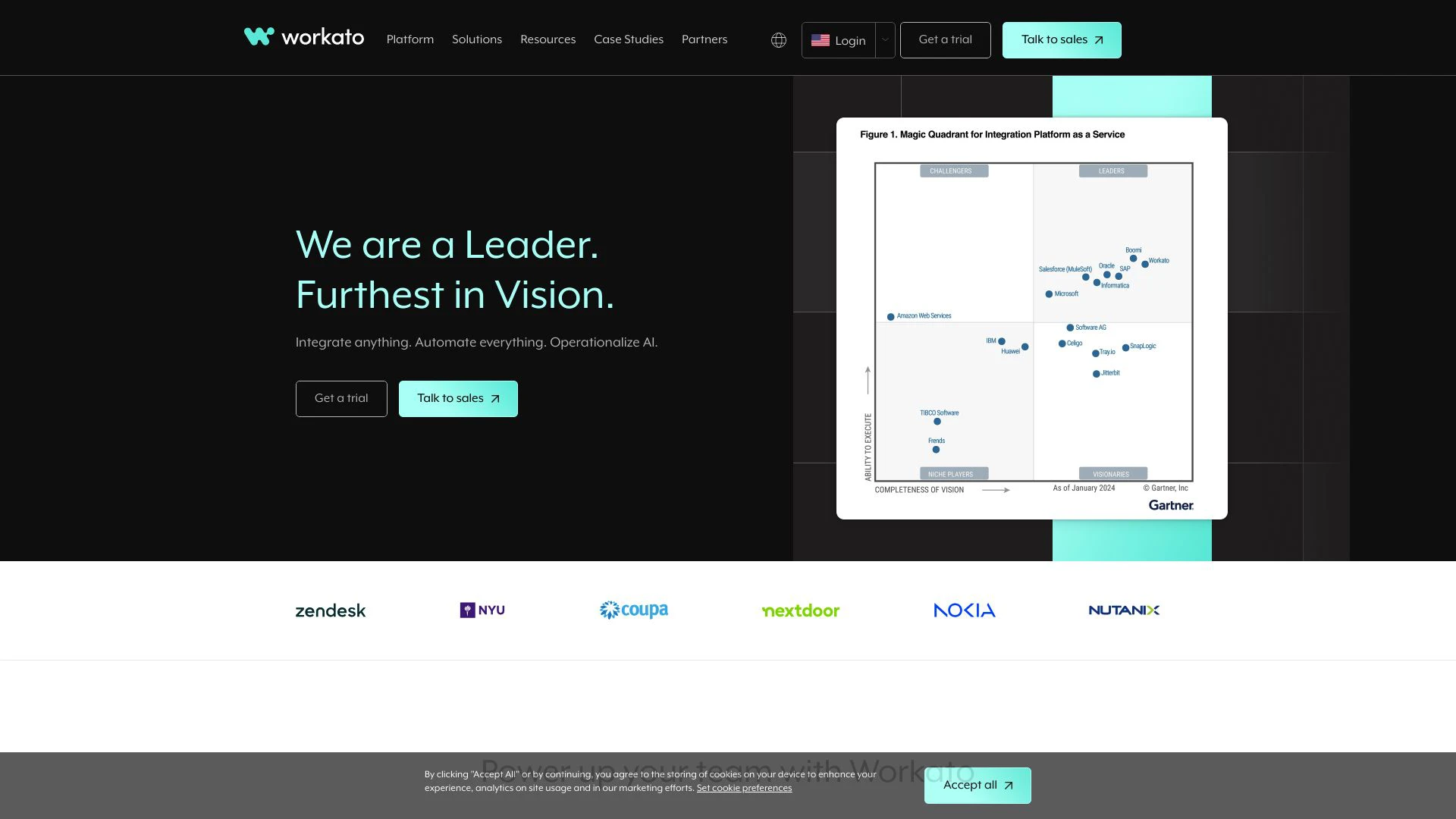AI-powered automation stands at the forefront of business innovation, transforming how organizations operate and compete. This review compares UiPath vs. Workato, and SmythOS, three leading platforms reshaping enterprise automation. UiPath excels in robotic process automation with its intuitive visual interface. Workato specializes in AI-driven workflow integration across applications. SmythOS emerges as a powerful alternative, combining robust automation capabilities with advanced AI features. We examine each platform’s strengths, limitations, and unique offerings to help you make an informed decision for your automation needs. Whether you’re a developer seeking API flexibility, a business leader focused on scalability, or a non-technical user looking for accessible tools, this comparison provides valuable insights to guide your choice in the evolving landscape of AI automation.
UiPath Overview
UiPath revolutionizes enterprise automation with its comprehensive platform. The company’s flagship product, the UiPath Platform, empowers organizations to discover, build, and manage software robots that automate repetitive tasks across departments. UiPath caters to a wide range of industries, from finance and healthcare to manufacturing and retail, offering solutions that boost productivity and streamline operations.
The UiPath Platform stands out for its user-friendly interface and powerful capabilities. At its core, UiPath Studio provides a visual development environment where users can design automation workflows using drag-and-drop functionality. This intuitive approach allows both seasoned developers and business users to create complex automations without extensive coding knowledge.
UiPath Studio provides a visual development environment where users can design automation workflows using drag-and-drop functionality.
UiPath enhances its offering with AI-powered tools like Document Understanding and AI Center. These features enable robots to process unstructured data and make intelligent decisions, expanding the scope of automation beyond simple, rule-based tasks. The platform’s scalability shines through UiPath Orchestrator, which manages and monitors robot deployment across the enterprise, ensuring smooth operations even as automation needs grow.

While UiPath excels in many areas, its complexity can be challenging for smaller organizations or those new to RPA. The platform’s enterprise focus means it may offer more features than necessary for simple automation tasks, potentially overwhelming users. Additionally, the licensing model and costs associated with scaling can be significant factors for budget-conscious businesses.
UiPath integrates seamlessly with a vast array of enterprise systems and applications. This compatibility extends to popular business software like SAP, Salesforce, and Microsoft Office, as well as custom in-house applications. The platform’s open architecture and robust API support facilitate connections with virtually any system, enabling end-to-end process automation across diverse IT landscapes.
Workato Overview
Workato offers a comprehensive automation platform that combines AI capabilities with robust workflow integration tools. The platform caters to businesses seeking to streamline operations through intelligent automation solutions.

Workato’s AI by Workato, developed in collaboration with OpenAI, enables users to integrate AI models and prompts into their workflows without compromising data privacy. This feature supports various AI-driven tasks such as text analysis, categorization, and translation. The platform’s low-code/no-code interface allows users to build complex automations quickly, making it accessible to both technical and non-technical team members.
Workato’s AI by Workato… enables users to integrate AI models and prompts into their workflows without compromising data privacy.
The platform excels in enterprise-grade workflow automation, offering robust data storage solutions and a customizable UI with drag-and-drop functionality. Workato provides pre-built solutions like Knowledge Workbot Accelerator and Actions by Large Language Model, facilitating the integration of knowledge bases and AI-driven actions within enterprise applications.
While Workato offers powerful capabilities, users should consider potential limitations. The platform imposes rate limits on AI actions, which may constrain high-volume use cases. Additionally, the lack of granular permission settings for AI features means all workspace collaborators have equal access, potentially raising security concerns for some organizations.
Workato’s enterprise focus ensures scalability, security, and governance features suitable for large organizations with complex automation needs. However, the associated costs may present a barrier for smaller businesses or those with limited budgets. The platform’s marketplace, featuring over 1,500 connectors and community recipes, fosters a collaborative environment for users to build and customize automations.
In summary, Workato positions itself as a versatile automation platform with strong AI integration capabilities, particularly suited for enterprises looking to enhance their workflow efficiency and leverage AI technologies within their existing systems.
Feature Comparison
UiPath and Workato offer distinct approaches to automation and integration, with key differences in their core components and security features. UiPath excels in robotic process automation (RPA) with its visual development environment, UiPath Studio, allowing users to design complex automation workflows through drag-and-drop functionality. Workato, on the other hand, focuses more on workflow automation and integration, leveraging AI capabilities to streamline business processes across various applications.
In terms of core components, UiPath provides robust tools for process mining, task capture, and document understanding, which are essential for automating repetitive tasks in enterprise environments. Workato’s strength lies in its extensive library of pre-built connectors and recipes, enabling quick integrations between different software applications. This difference highlights UiPath’s focus on mimicking human actions for automation versus Workato’s emphasis on connecting disparate systems.
Security features also diverge between the two platforms. UiPath offers fine-grained access controls and role-based permissions, crucial for large enterprises with complex security requirements. Workato, while providing strong encryption and compliance features, lacks the granular permission settings for its AI features that UiPath offers for its automation components. This gap in Workato’s security model may be a concern for organizations requiring strict control over AI-driven processes.
Feature Comparison Table
| UiPath | Workato | SmythOS | |
|---|---|---|---|
| CORE FEATURES | |||
| AI Agents | ❌ | ✅ | ✅ |
| Hosted Agents (Dev, Production) | ❌ | ✅ | ✅ |
| No-Code Options | ❌ | ✅ | ✅ |
| Memory & Context | ❌ | ✅ | ✅ |
| Autonomous Agents | ❌ | ❌ | ✅ |
| Explainability & Transparency | ❌ | ✅ | ✅ |
| Multimodal | ❌ | ❌ | ✅ |
| Problem-Solving Capabilities | ❌ | ✅ | ✅ |
| Multi-Agent Collaboration | ❌ | ❌ | ✅ |
| Work as Team | ❌ | ✅ | ✅ |
| SECURITY | |||
| Constrained Alignment | ❌ | ❌ | ✅ |
| COMPONENTS | |||
| Foundation AIs | ❌ | ✅ | ✅ |
| Huggingface AIs | ❌ | ❌ | ✅ |
| Zapier APIs | ❌ | ❌ | ✅ |
| Classifiers | ❌ | ✅ | ✅ |
| Data Lakes | ❌ | ❌ | ✅ |
| DEPLOYMENT OPTIONS (EMBODIMENTS) | |||
| Deploy as API | ❌ | ✅ | ✅ |
| Deploy as Webhook | ❌ | ✅ | ✅ |
| Staging Domains | ❌ | ✅ | ✅ |
| Production Domains | ❌ | ✅ | ✅ |
| Deploy as Site Chat | ❌ | ✅ | ✅ |
| Deploy as Scheduled Agent | ❌ | ✅ | ✅ |
| Deploy as GPT | ❌ | ✅ | ✅ |
| DATA LAKE SUPPORT | |||
| Hosted Vector Database | ❌ | ❌ | ✅ |
| Sitemap Crawler | ❌ | ❌ | ✅ |
| YouTube Transcript Crawler | ❌ | ❌ | ✅ |
| URL Crawler | ❌ | ❌ | ✅ |
| TXT File Support | ❌ | ✅ | ✅ |
Best Alternative to UiPath and Workato
SmythOS stands out as the superior alternative to UiPath and Workato for AI-powered automation and integration. Our platform offers a comprehensive solution that combines the best of both worlds — powerful AI capabilities and seamless workflow automation.
We deliver unmatched flexibility through our drag-and-drop interface, enabling users to create sophisticated AI agents without extensive coding knowledge. This approach democratizes AI development, making it accessible to a broader audience while still providing the depth of functionality required by experienced developers.
We deliver unmatched flexibility through our drag-and-drop interface, enabling users to create sophisticated AI agents without extensive coding knowledge.
Our platform excels in areas where UiPath and Workato fall short. While UiPath focuses primarily on robotic process automation and Workato emphasizes workflow integration, SmythOS provides a unified environment for creating truly intelligent, autonomous agents. We support multimodal interactions, problem-solving capabilities, and multi-agent collaboration — features notably absent from our competitors’ offerings.
SmythOS’s commitment to security and scalability sets us apart. We offer constrained alignment features to ensure AI behavior aligns with organizational goals, a capability neither UiPath nor Workato provides. Our platform also includes a hosted vector database and supports various data crawlers, enabling more comprehensive data handling than our competitors.
By choosing SmythOS, users gain access to a future-proof platform that continually evolves to meet the changing demands of AI development. Our extensive integration options, deployment flexibility, and focus on user-friendly design make us the ideal choice for businesses of all sizes looking to leverage the full potential of AI in their operations.
Conclusion
UiPath and Workato offer robust automation solutions tailored for enterprise needs, each with distinct strengths. UiPath excels in RPA with its intuitive UiPath Studio, empowering users to create complex automations through visual workflows. Workato shines in workflow integration, leveraging AI to streamline processes across diverse applications.
While both platforms cater to large organizations, they present different approaches to automation. UiPath focuses on mimicking human actions, ideal for repetitive task automation. Workato emphasizes system integration, connecting disparate software effortlessly. However, both face limitations — UiPath’s complexity may overwhelm smaller teams, while Workato’s AI feature permissions lack granularity.
SmythOS emerges as a superior alternative, addressing the limitations of both UiPath and Workato while offering unique advantages. Our platform combines the ease of use found in Workato’s low-code interface with UiPath’s powerful automation capabilities, all while providing advanced AI integration that surpasses both competitors. SmythOS’s drag-and-drop interface, extensive API integrations, and support for multiple AI models make it accessible to both technical and non-technical users.
We invite you to experience the future of AI-powered automation with SmythOS. Create a free account today and discover how our platform can transform your workflow, boost productivity, and drive innovation in your organization. With our 30-day money-back guarantee, you can explore SmythOS risk-free and see firsthand why it’s the smart choice for businesses looking to harness the full potential of AI automation.